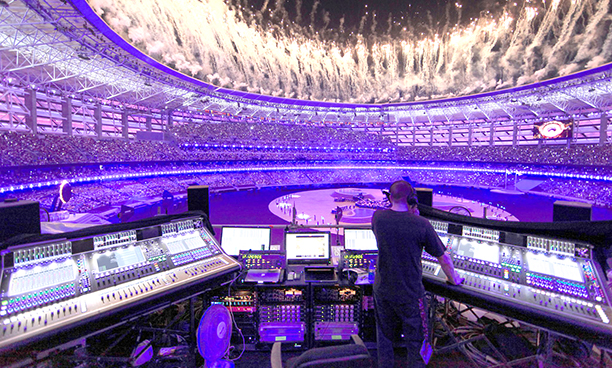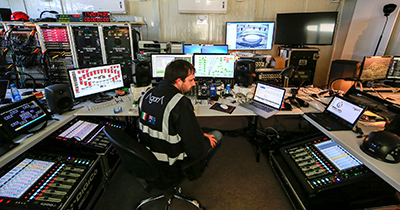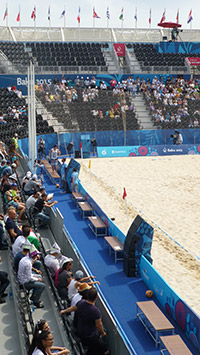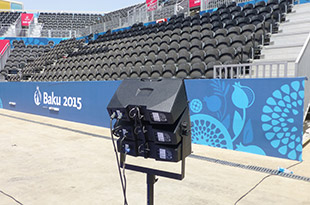
The inaugural European Games was staged in the new, 68,000-capacity Olympic Stadium in the Azerbaijan capital of Baku. Organised by the European Olympic Committee, its opening and closing ceremonies were on a similar scale to established sports spectaculars and required an experienced team to handle the sound.
Overseeing audio design and delivery for both live and broadcast was Scott Willsallen: ‘These events are primarily about the TV pictures,’ he says. ‘However, as they take place in the round, the audience is in the background of most camera shots, so the more engaged and enthusiastic they are, the more interesting it is for viewers at home.’
To ensure that both the stadium and broadcast audiences were served a high-quality soundtrack to the ceremonies, Wilsallen used a set-up that included pairs of DiGiCo SD7 mixing consoles at FOH and monitors, plus an additional pair of SD11s at monitors. A further SD7 was employed in the closing ceremony rehearsal venue, so that the show file could be saved and loaded into the stadium consoles when required.
‘We had two completely independent control systems in the stadium, the consoles acting as mirrored pairs,’ Willsallen continues. ‘The primary system used an Optocore network, with 24 network devices positioned around the stadium. Eight Optocore nodes were located around the field of play, plus four in the roof, from each of which nearby inputs - such as crowd microphones or local wireless receivers - were gathered and mix outputs were fed to L-Acoustics racks for the PA.’
The secondary set of consoles all had SD-Racks located in a patch room. The field inputs were patched into a passive splitter, with one output going to the Optocore mic preamp for the primary system and a second output to a mic preamp with fixed stepped gain. A 25-pair Cat5 cable ran between each Optocore node and the patch room for analogue connectivity. From there it was routed to a punch-down panel and an active splitter that allowed it to be split to the backup FOH, monitor and broadcast consoles.
 ‘Using mirrored FOH mixing consoles feeding both signal transport networks meant that the mix arriving at the amplifiers via Optocore sounded exactly the same as the mix on the analogue cable,’ Willsallen says. ‘We switched between the two based on AES sync, so if that failed the nodes automatically switched. If there was a failure on the primary consoles, we switched to analogue by hitting a button, then switched back when the primary network was running again. To test it, we switched systems a few times during the dress rehearsals and nobody noticed, which was very satisfying.’
‘Using mirrored FOH mixing consoles feeding both signal transport networks meant that the mix arriving at the amplifiers via Optocore sounded exactly the same as the mix on the analogue cable,’ Willsallen says. ‘We switched between the two based on AES sync, so if that failed the nodes automatically switched. If there was a failure on the primary consoles, we switched to analogue by hitting a button, then switched back when the primary network was running again. To test it, we switched systems a few times during the dress rehearsals and nobody noticed, which was very satisfying.’
Microphone inputs were fed into multiple receive stations scattered around the field ensuring every mic would be picked up in several places at the same time. The other main audio source was a Fairlight replay system, featuring primary and secondary AB-roll systems. ‘It meant we had four replay systems available to us, allowing the AB-roll within the primary link to be one Madi stream that we distributed to all the consoles,’ says Willsallen. ‘Click or guide tracks for the live bands were also provided via the Fairlight system, delivered to the monitor consoles via Madi.
‘These events are divided up into music cues that correspond with a segment of movement or action in the performance area. Each one was called by the show caller and the console operators recalled a snapshot for each specific music cue. Overall levels and featured instruments were then mixed on the fly. The live acts – including Lady Gaga, Clean Bandit and John Newman, as well as the live speeches – were all operated in the same fashion.’
For the broadcast mix, two DiGiCo SD7Bs and two SD11Bs were deployed, again working as mirrored pairs. Integrated with the stadium system, all the crowd microphones were plugged into the Optocore nodes, which were fed to the Delta Media 3 broadcast truck, sub hired by Agora.Delta Sound’s Griff Hewis, assisted by two Agora broadcast engineers, was systems engineer and mixed the atmosphere microphones. .
‘We took a Madi stream from the replay systems into the SD7Bs and the crowd microphones were fed into the SD11Bs. They provided a 5.1 atmosphere buss into the SD7Bs and we then used the Optocore loop to provide the highway between us and International Sports Broadcasting, the host broadcaster,’ says Willsallen. ‘None of the rights holders took 5.1 for this event, so we provided a stereo mix of the events plus crowd and a crowd-only mix.’
Once the systems were settled, Willsallen and Andy Rose (broadcast sound supervisor) watched all the camera cuts and made sure that the audio broadcast during each shot made sense: ‘Andy and I tried to pick up every little bit of detail, so that the audio and the vision matched perfectly. The aim is always to make the broadcast sound as detailed as it looks,’ says Willsallen.
‘Our entire system is always on uninterruptible power supplies and, while the amount of redundancy may seem excessive, it means a lot has to go wrong before there’s a problem.’
The venues and their sound
The competitions themselves took place across a number of venues – some permanent, some temporary, some large, some small. Specialist audio supplier, Dimension, and Sports Technology Director, Damian Rowe had the challenging task of supplying audio systems for the competition venues throughout the games, and for the many corporate and press facilities that required a pro audio presence.
 Rowe is no stranger to events of this magnitude – a veteran of the Sochi Winter Olympics, London 2012 and the Glasgow Commonwealth Games, his CV is itself a gold standard: ‘Across the 21 venues, more than half were rigged with d&b audiotechnik loudspeakers as their primary systems. Wherever possible, we choose d&b for this type of job for one very simple reason: they are the best product available. The combination of power, processing and control you get from the wide range of systems is unsurpassed.’
Rowe is no stranger to events of this magnitude – a veteran of the Sochi Winter Olympics, London 2012 and the Glasgow Commonwealth Games, his CV is itself a gold standard: ‘Across the 21 venues, more than half were rigged with d&b audiotechnik loudspeakers as their primary systems. Wherever possible, we choose d&b for this type of job for one very simple reason: they are the best product available. The combination of power, processing and control you get from the wide range of systems is unsurpassed.’
Project Manager Mike Sumner was Head of Audio at Glasgow and Baku, and worked alongside Sports Technology in Sochi and London. ‘It’s probably easier to say which d&b systems we didn’t use rather than the ones we did,’ he reports. ‘T10s were the perfect choice for the Basketball Arena that had a capacity of two and a half thousand, while the nearly 4,000-seat Beach Arena, that hosted beach volleyball and beach soccer, was rigged with V-Series. In other venues we made use of Q7s, B4s and M4s for example. No matter which product is chosen from the range, be it new or old, d&b reliability and quality of sound reinforcement is a given. The value of that is hard to quantify, especially when you are working so far away from home.
‘In the Crystal Hall indoor arena – originally built for the Eurovision Song Contest – there were three venues. In the boxing venue, we used an almost identical T10 system to the one that was in both the Excel Centre for London 2012 and the SECC for the Glasgow games, a solid endorsement of that loudspeaker as one could get.’
However, in the Crystal Hall venue for fencing, karate and taekwondo, Sumner tried something new. The Y10P loudspeakers were used as a point-source system as there was no means of flying an array. This was something of a difficult space that was changed around dependent on which sport was being played. ‘I’d never used them before; easy to rig, and performed exceptionally well, giving a warm feel in the low to mid range,’ he says.
 ‘I use ArrayCalc throughout the planning process and then once we’re onsite it plays an invaluable role. With events of this nature, we visit the venues and measure the rooms that are then built into ArrayCalc. But, of course, it’s not unusual to find that the venues are not completed in time or when we arrive onsite the spaces have been altered significantly.
‘I use ArrayCalc throughout the planning process and then once we’re onsite it plays an invaluable role. With events of this nature, we visit the venues and measure the rooms that are then built into ArrayCalc. But, of course, it’s not unusual to find that the venues are not completed in time or when we arrive onsite the spaces have been altered significantly.
With ArrayCalc we can pitch up and make the necessary changes without it becoming a time consuming or logistical nightmare. I wouldn’t leave home without it. Even when we are using loudspeakers from another manufacturer, that don’t offer a calculation programme, I would still refer to ArrayCalc to offer a ballpark solution. The fact that it’s free and available to everyone is amazing.’
Providing appropriate audio solutions for everything from morning press conferences to huge sporting events is always a challenging project and necessarily fraught with unforeseen difficulties, changes and frustrations. Sumner undoubtedly views d&b audiotechnik loudspeaker systems as somewhere he can comfortably hang his hat. ‘There are many reasons that I would always be happy using a d&b system at an event such as this; not least that they perform so well. There is always a speaker in the d&b range that will fit the job perfectly and the fact everything is so interchangeable means that, across twenty odd venues, we were able to provide the right solution in the right place. In an environment where help can be hard to come by easily, a choice of d&b loudspeakers is something of a “get out of jail card” for me.’
More: www.digico.biz
More: www.optocore.com
More: www.dbaudio.com